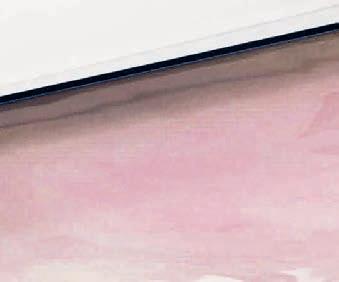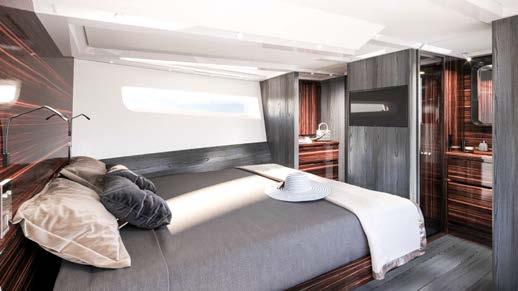
7 minute read
P54 Fiart


PPreview
IL NUOVO 54 DI FIART È STATO PROGETTATO
DA STEFANO PASTROVICH E SARÀ
PRESENTATO AL PROSSIMO CANNES
YACHTING FESTIVAL
FIART’S NEW 54 WAS DESIGNED BY STEFANO
PASTROVICH AND WILL MAKE ITS DEBUT
AT THE NEXT CANNES YACHTING FESTIVAL by Niccolò Volp i



Rivoluzione copernicana Copernican REVOLUTION



«Fiart ha avuto un approccio che è il sogno di qualsiasi progettista», racconta Stefano Pastrovich. «All’inizio mi hanno dato delle s eci che se licissi e Io mi sono messo a fare un’indagine di ercato er ca ire che cosa offriva la concorrenza e quale poteva essere la soluzione che soddisfaceva le richieste del cantiere a l sia o andati avanti un asso alla volta attone su attone». Pochi paletti, massima libertà creativa, ma anche sostegno. Queste sono state le carte vincenti che ha offerto Fiart a Stefano Pastrovich. «Sono partito dai volumi – spiega il progettista – che a io avviso sono irrinunciabili ono un architetto a vado in barca da quando ero ba bino e non ho ai s esso ottoco erta ci vo liono due etri di abitabilit la cuccetta matrimoniale deve essere larga 160 cm e il piatto doccia 120x75 cm come a casa e dero hi da queste di ensioni o se imbrogli con i trucchetti che tutti conoscia o la barca non con ortevole a questi calcoli sui volu i sono arrivato alle di ensioni della barca ri a ho i otizzato un iedi oi e alla ne in accordo con il cantiere e con Simone orenzano eneral ana er iart abbia o deciso che la taglia giusta per garantire i
Sottocoperta, oltre a due grandi cabine c’è una grande area lounge e un’abitabilità di due metri.
Below decks, as well as two large cabins, there is a large lounge area with two meters of headroom.


Pastrovich ha curato tutto il progetto: carena, interni e coperta. Sopra, Simone Lorenzano, Stefano Pastrovich e Giancarlo di Luggo.
Stefano Pastrovich has handled the whole project: hull, interior, and deck. Above, Simone Lorenzano, Stefano Pastrovich and Giancarlo di Luggo.
volumi che giudicavamo irrinunciabili era 54 piedi». L’intento del P54 mi sembra quello di coniugare comfort senza rinunciare all’aspetto estetico. È quello che posso dedurre dai rendering e dal modellino, dai quali si può dire che il P54 mantiene una forma sinuosa e piacevole. È una barca elegante, ma non per forza appariscente. E così dovrebbe essere anche la carena, disegnata da astrovich in collabora ione con l u cio tecnico del cantiere. Un’imbarcazione confortevole, ma sportiva, deve avere una carena e ciente, in grado di planare in pochi secondi e di navigare senza dividere le acque del Mar Rosso come Mosè. I motori saranno gli Ips di Volvo Penta con tre diverse opzioni di potenza. Quella più contenuta dovrebbe garantire una velocità massima di 35 nodi, mentre quella maggiore porterà P54 fino a nodi. l layout della coperta è caratterizzato da un rollbar a cui, se lo desidera l’armatore, si può aggiungere un T-Top. Non ci sono passavanti laterali perché l’accesso a prua è garantito da un camminamento centrale. Gli arredi, sia prendisole sia sedute, lasciano sempre spazio intorno per facilitare il passaggio. C’è sempre un corridoio da percorrere per spostarsi, non è necessario scavalcare nulla. Sottocoperta ci sono due cabine con due bagni oppure esiste una versione a tre cabine e a poppa c’è un ampio garage per il tender perché un piedi non pu accontentarsi di un piccolo gommone di poco più di due metri di lunghezza. L’obiettivo del cantiere è creare modelli capaci di durare nel tempo. Questo consente di ammortizzare meglio l’investimento per ogni nuova realizzazione. E dal successo di uno si può ipotizzare il passaggio a quello successivo. È stato così con la gamma SeaWalker, che in modo costante cresciuta fino a presentare tre modelli il , il e il . probabilmente anche P54 sarà destinato a sostenere lo sviluppo di altre imbarcazioni. La fascia tra e piedi uella pi vitale sul mercato, ma P54 ha un design che la distingue da quello che si incontra generalmente in banchina durante i saloni nautici. Non resta che aspettare la prova in acqua per capire se le promesse saranno mantenute.

«Fiart took the kind of approach that is a dream for any designer», says Stefano Pastrovich. «At the start, they ave e ver strai ht or ard s eci cations I did some market research to work out hat the co etition as offerin and what could be a solution that met the yard’s requirements. We moved forward from there, one step at a time, gradually building upon what we had». Not a lot of boundaries, complete creative freedom, but also support. Those were the winning cards that Fiart offered



Stefano Pastrovich. «I started from the layout and dimensions», explained the designer, «which I feel are indispensable. I am an architect, but I have been going on boats since I was a child, and I have never stopped. Below decks you need two meters of headroom, the double bed has to be 160 cm wide, and the shower has to be 120x75 cm, like at home. If you take away from those measurements or get mixed up with the kind of tricks that we all know about, you don’t get a comfortable boat. So, from those calculations involving volumes, I got to the size o the boat t rst as thin in o a t ooter then eet and in the end and with the agreement of the yard and the Fiart general manager, Simone Lorenzano, we decided that the right size to deliver the volumes that we felt were indispensable was 54 feet». To me, it looks as if the P54 is trying to provide comfort while not losing the aesthetic element. That is what I deduced from the rendering and the rendering and scale model, which show that the P54 has a pleasing, curved shape. It is an elegant boat, but not necessarily a showy one. And that is also how it should be with the hull, which was designed by Pastrovich together with the yard’s technical department. A comfortable and yet sporty boat has to have an e cient hull, one that can start planning in just a few seconds and that move through the water without dividing it like Moses in the Red Sea. Volvo Penta IPS engines will be used, with three power ratings available. The least powerful should deliver 35 knots top speed, while the most powerful will get the P54 up to 46 knots. The deck layout features a rollbar to which a T-Top can be added. There aren’t any gangways along the sides, because you get to the bow down the middle of the boat. The furniture, both sun pad and chairs, always leave enough room to get through – so there is always a passageway clear and you don’t have to move anything. Below deck, there are two cabins with two bathrooms, or there is a three-cabin version. While in the stern there is a large garage for the tender since a 54foot boat can’t make do with a dinghy of barely two meters. The yard is aiming to create boats that will last over time. That approach means they can better depreciate the investment made on each new model. And when one becomes successful, you can work out how to move on to the next. That is how it was with the SeaWalker range, which has steadily grown to include three models: the 35, 29, and the 43. And the P54 will probably also be destined to support the development of other boats. The range between 55 and 60 feet is the most important in the market, but the P54 has a design that makes it stand out from what can normally be found at the dock during a boat show. We just have to wait to try it out to see if it lives up to its promise.

Poppa e prua rovescia per l’estetica, ma anche per la funzionalità. La V di prua per a rontare il mare ormato e da poppa si apre la piattaforma che delimita il garage del tender.
The inverted bow and stern look good but are also functional. There is a V-bow to handle moderate seas and, in the stern, the platform opens up to reveal the tender garage.











